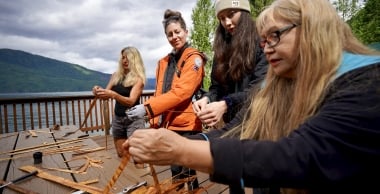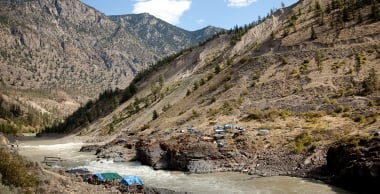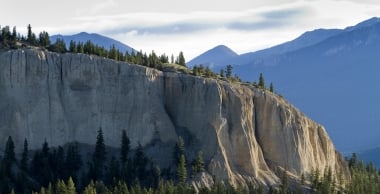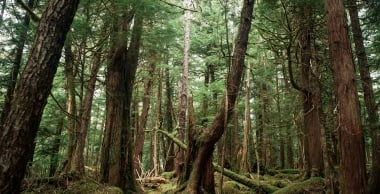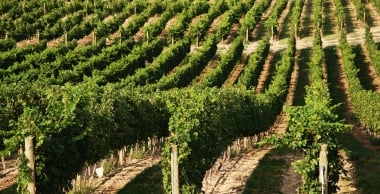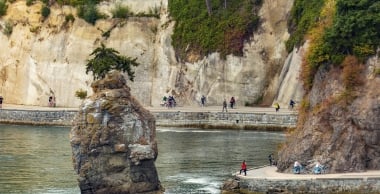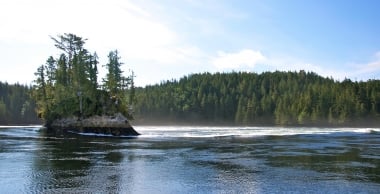Visit: Corporate Site
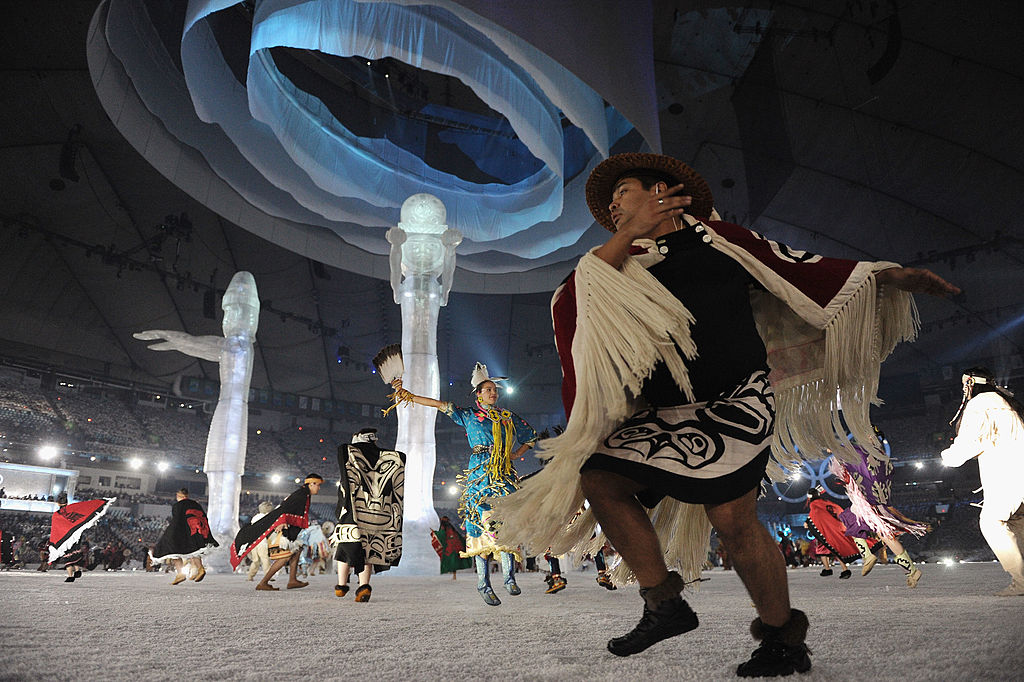
February marks the 10th anniversary of the Vancouver 2010 Winter Olympics, an event brought Indigenous cultures in Canada to a global audience. The first-ever equal partnership between VANOC and local Indigenous communities created a lasting legacy of enduring friendships, increased awareness, and celebration of Indigenous cultures in BC.
Knowledge Transfer and Active Partnership
Whonoak, Dennis Thomas, of Tsleil-Waututh Nation remembers the gold medal hockey game. And the buzz of the estimated 75, 000 daily visitors who came to witness and share Indigenous culture, ceremony, and art at the Four First Host Nations Pavillion.”We were able to show who we were and everyone loved it,” he says.
Thomas represented Tsleil-Waututh Nation for three years as one of four first host nations knowledge transfer coordinators, responsible for local Indigenous knowledge transfer to VANOC and other visiting Indigenous Nations. He also represented his Nation as a speaker in the opening ceremonies. A welcome was offered by each of the First Host Nations–Tsleil-Waututh, Squamish, Musqueam, and Lil’ wat–and Thomas greeted the audience in the Hunq’eme’ nem language.
Indigenous Canada on the World Stage
The highly choreographed performance, complete with welcome poles that lifted from the arena floor, was followed by an impressive entrance of more than 345 Indigenous dancers from across Canada. Dressed in traditional and powwow regalia and dancing in their own styles, the dancers endured throughout the procession of Olympic athletes.
With more than 13 million viewers, it was the most-watched event in Canadian television history. Thomas says: “It brought us all together on a world stage to give a pure representation of the local Indigenous Nations, whether it be from the cultural aspect to economic development opportunities, for sharing our culture and our history, and to be an actual active partner.”
It was a dramatic Indigenous entrance to the world stage. It was also the first time that the Olympics acknowledged Indigenous cultures in a way that moved beyond performance and into improved, more equal, and meaningful partnerships between VANOC, the Province of BC, and the host Nations.
Trendsetting and Trailblazing
Developing protocols and agreements and building relationships with each other during the Olympic games built a foundation for the continued practice of protocol at public events. In 2013, Musqueam, Squamish, and Tsleil-Waututuh Nations formed a powerful alliance–an economic development corporation (MST) that uses its resources to purchase within their Traditional Territories.
Thomas acknowledges: “That stems from the Olympic experience. We’ve got to keep building on that momentum. And I strongly believe that that feeling and experience that happened during the Olympics helped spark that dialogue and conversation.”
Ten years later, Henry Tso, CFO at Indigenous Tourism BC (ITBC), reflects on how the firsts at Vancouver 2010 are the trends and legacies of 2020.
ITBC helped to activate five unique projects for the 2010 Olympics, including the first-ever Klahowya Village–an Indigenous welcome center located in the lobby of the Pan Pacific Hotel for the duration of the Olympics. Tso remembers being part of the team that carried a one-ton, 40-foot long Tsimshian cedar canoe up escalators to the atrium lobby. Klahowya continued as a legacy project at Stanley Park.
Tso and the ITBC team trained the ambassadors and volunteers for service at the Four First Host Nations Pavillion, located near the Queen Elizabeth Theatre. They organized Indigenous culinary events and helped to organize a fashion show at the Robson Square open-ice arena.
Tso remembers being moved by two young Indigenous women beside him in tears, overwhelmed at the pride they felt watching the fashion show. “It was one of those moments that make you realize that what we’re doing here is making a difference, and it’s tangible,” he reminisces.
Indigenous Empowerment and Cultural Sharing
Cheximiya, Allison Burns Joseph, was one of the hundreds of dancers who made a grand entry at the Opening Ceremonies.
The young performers–who initially thought they were gathering for a youth conference– resided north of Vancouver for the two weeks before the Olympics, bussing into BC Place for daily rehearsals and spending nights together sharing songs, stories, and eating an Indigenous menu.
Cheximiya tried throat singing for the first time at the Whistler 2010 Olympics. The diverse group shared their teachings and learned from each other: “Some people in my group were letting me know that they had never seen a flower before because they were from the Yukon, or had never seen street signs because they came from a rural location. And so it was a real eye-opening experience for me, as someone who was born and raised in Vancouver,” she shares.
This experience helps Burns Joseph in her current role as manager of the Indigenous Youth Ambassador Progam at Squamish Lil’wat Cultural Center (SLCC). The lessons she learned on the diversity of Indigenous cultures gave her a consciousness of the differences between Indigenous cultures in Canada, valuable education that she shares with international guests at the SLCC.
“The idea of the gathering was so much more than just opening up the ceremonies. It was really bringing our cultures and our connections together and making friends that I still have today from that experience,” says Cheximiya.
One of those friends is Jolene Sampare, a museum coordinator at the Nisga’a Museum in Laxgalts’ap, BC. The two women have stayed connected on social media and even studied together since they met in 2010.
Sampare says the hype and emotion of the experience intensified as the opening ceremonies grew closer: “It literally empowered us for who we are as Indigenous people.”
Positive Stories and Lasting Friendships
One of her fondest memories of the experience is the sense of pride and anticipation she had as the clock counted down, and dancers were cued to begin their run from the change rooms, down the hallway, and to their stage entrances.
“The anticipation for that moment–your moment–on that stage, it’s like right there, and it’s coming. We were running down, and we saw all of the teams from all over the world standing there, and as we were running by, they all just stopped and were in awe of all of us–like we were the ones that everybody was there for,” Sampare shares.
In the moments before she took the stage, she was overwhelmed: “It was then I got emotional. I can still feel that right now. The sense of pride. We all went arm to arm, heads down, and did a prayer. We ran up the stairs, got on to the stage and that was it. Right when we got off we were met with hugs. It was a cloud-nine-type feeling.”
Sampare recently watched the inspiring video of the Vancouver 2010 Opening Ceremonies and it all came back. She showed her children and was once again overwhelmed with emotion and pride. She says it was then she realized ‘Oh my goodness. I’m a part of history.’



















